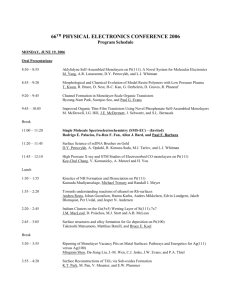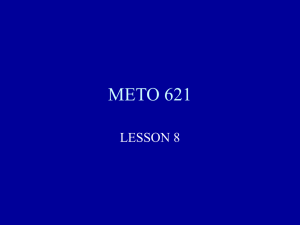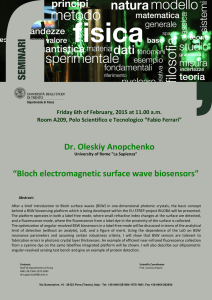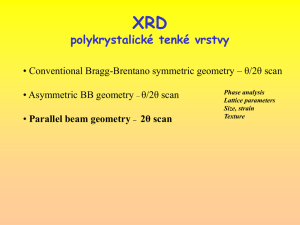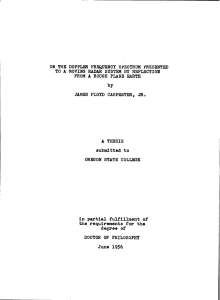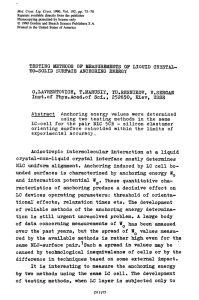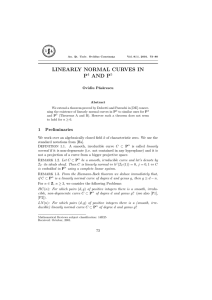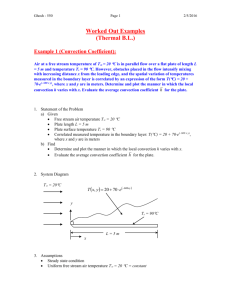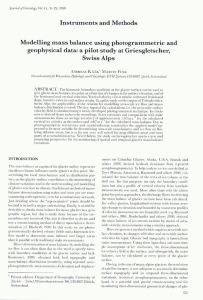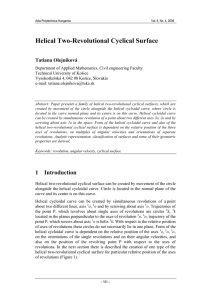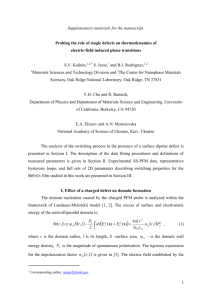Diapositiva 1 - Università degli studi di Pavia
advertisement
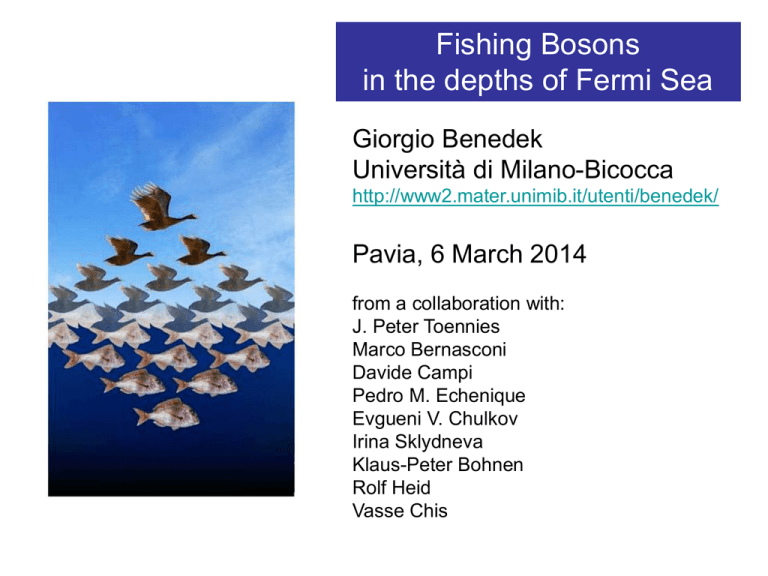
Fishing Bosons in the depths of Fermi Sea Giorgio Benedek Università di Milano-Bicocca http://www2.mater.unimib.it/utenti/benedek/ Pavia, 6 March 2014 from a collaboration with: J. Peter Toennies Marco Bernasconi Davide Campi Pedro M. Echenique Evgueni V. Chulkov Irina Sklydneva Klaus-Peter Bohnen Rolf Heid Vasse Chis Condensed matter: the Fermion & Boson zoo Fermions: - electrons, holes, protons, neutrons, - neutral atoms (A = odd) Bosons: - photons - Cooper pairs - neutral atoms (A =even) - Elementary excitations (and their quanta) - e-h pairs, excitons - phonons - plasmons - magnons - rotons - polaritons - plasmarons Welcome to the Fermi Sea Otto Stern (Sohrau 1888 – Berkeley 1969) Nobel Laureate 1943 Otto Stern, O.R. Frisch, I. Estermann (Hamburg, 1929-1933). He 2 4.542 [Å] 1 k[Å ] Ei [meV] k (K , k z ) k f ki 2 K G G (m, n) a a NaCl(001) Supersonic nozzle beam sources J. P. Toennies: HUGO (MPI-SF, Goettingen) Angular distributions Diffraction Inelastic processes: - inelastic bound state resonances - kinematical focussing kf d 2( 1 ) | 1 n(E ) | F fi ImG(ΔE ) Fif dE f dΩ f kiz Manson and Celli (1971) GB (GF formulation, 1973) u*Q (0)u Q (0) G (ΔE ) Qv E f -Ei Qv i 0 displacements of the SURFACE atoms (layer index = 0) …to a slab of Nz layers Surface phonons 2: from one monolayer… Time-of-Flight spectra Longitudinal resonance Rayleigh wave U. Harten, J.P. Toennies and Ch. Wöll (1983-85) The bones and the skin! Questions: 1) Why the longitudinal resonance is so soft? 2) Why is it observed at all? 3) Why is it found in ALL metals? Giorgio, Vittorio & Peter Bibi V. Chis, B. Hellsing, G. Benedek, M. Bernasconi, E. V. Chulkov, and J. P. Toennies “Large Surface Charge-density Oscillations Induced by Subsurface Phonon Resonances” Phys. Rev. Letters, 101, 206102 (2008) DFPT + SCDO for Cu(111) Phonon-induced surface charge-density oscillations Why so many phonons? Milano (Bernasconi, GB) Göttingen (JPT) DIPC (Chulkov) Karlsruhe (Bohnen, Heid) The quantum sonar effect Bi(111) Pb(111) Theory: DFPT (mixed plane + spherical wave basis) for a 5 or 7 ML film on a rigid substrate Pb/Cu(111) Surface charge density oscillations of the topmost modes at Q = 0 5 ML Pb/rigid substrate Almost identical SCDO’s for two completely different modes: just as found in HAS experiments! HAS perceives underground phonons (5 layers deep) via e-p interaction ! HAS scattering intensities kf 2 d 2( 1 ) [1 nBE (E )] Qv Kn V fi (Kn, Q ) (E Qv ) dE f dΩ f k i V (r,t) A n(r, t ) f n Kn,Q (r ) i A n ' the non-diagonal elements of the electron density matrix act as effective inelastic scattering potential f K n (r ) K +Q n' (r ) i EKn EK Q n ' Q g nn ' (K , K + Q ; ) electron-phonon interaction matrix (Q, ) 0 (Q, ) 1 (4 e2 / Q2 ) 0 (Q, ) electronic susceptibility mode-selected e-p coupling lambda Kn n' g nn ' (K , K Q ; ) f K n (r ) K Q n' (r ) i 2 1 N ( EF ) Q3 Q I ( Q ) 2 d 2(1) f (E ) N ( E F )Qv Qv (E Qv ) dE f dΩ f a slowly varying function HAS from metal surfaces and thin films can measure the mode-selected electron-phonon coupling constants ! Persistent SC in Pb/Si(111) 16 ML down to 1 ! S. Qin, J. Kim, Q. Niu, and C.-K. Shih, Science 324,1314 (2009). T. Zhang, P. Cheng, W.-J. Li, Y.-J. Sun, G. Wang, X.-G. Zhu, K. He, L. Wang, X. Ma, X. Chen, Y. Wang, Y. Liu, H.-Q. Lin, J.F. J ia, and Q.-K. Xue, Nature Physics 6, 104-108 (2010). Superconductivity in Pb/Si(111) ultra-thin films Theory predicts also the drop of total and Tc below 4 ML ! The interface mode is the culprit for SC! 1 Acoustic Surface Plasmons (ASP) observed by HAS in Cu(111)! ASP0 ASP Band structure of graphene Dirac massless fermions Dirac massive fermions Graphene / Ru(0001)0 HAS: Daniel Farias (Madrid) DIRAC? p ( K q), c K / 2m E ( p) p 2c 2 m2 c 4 m 1 m | 1 TK / 2U K | m m m m m 1019 m mP back to solid (K ) 2 TK 2m m mP hc hG , 2a P G c3 m m c (m m ) G P Δ m hc VG (r ) mP r Planck lattice 2 h 2 mh me Veh (r ) 0.1 eV 2 r 4am at r = a Conclusions: HAS can measure deep sub-surface phonons in metal films: a complete spectroscopy (not accessible to other probes such as EELS) HAS can directly measure the mode-selected electron-phonon coupling in metals: a fundamental information a) for the theory of 2D superconductivity b) for the theory of IETS (STS) intensities c) for understanding phonon-assisted surface reactions, etc. d) chiral symmetry break: graphene, topological insulators,... HAS can measure acoustic surface plasmons New trends: Bi(111), and TIs: Sb(111), Bi2Se3 ,... New extraordinary possibilities: TU Graz 3He spin-echo spectroscopy new adventures with Otto Stern’s invention, a new life for HAS ! Pavia Milano R.do The Cavendish He3 SpinEcho Apparatus Parameter Value Total scattering angle 44.4 degrees 3He Angular Resolution 0.1 degree Nominal beam energy 8 meV Measured beam intensity 1e14 atoms/second Beam diameter at target 2 mm Energy resolution (QE peak width) 20 neV Scattering chamber base pressure 2e-10 mbar Sample manipulator 6 axis, titanium Sample manipulator resolution 0.003 degrees Sample heating Radiation / E-beam Sample cooling Liquid Nitrogen or Helium Sample temperature range 55 K - >1200 K Exploiting the old paradox: - impact EELS doesn’t see valence electrons! - neutral atoms interact inelastically via valence electrons!! - phonons via electron-phonon interaction - acoustic surface plasmons - surface excitons in insulators (with keV neutrals: H. Winter et al) - with 3He spin echo: slow dynamics (diffusion) magnetic excitations (?) - plasmarons (topological insulators, graphene...) The Multipole Expansion (ME) Method C.S. Jayanthi, H. Bilz, W. Kress and G. Benedek, Phys. Rev. Letters 59, 795 (1987) (after an idea of Phil Allen for the superconducting phonon anomalies of Nb) E Eion F[n(r)] v ion (r)n(r)d 3r v ion (r) l v l (r rl u(l )) nl r C l Y r rl C (l) C0, (l) c (l) Equilibrium: E c l 0 Γ, l , E Eo 1 R l , l u l u l 2 l ,l 1 [ T l , l T l ' , l ] u l c l l ,l 2 1 l ,l j H ' l , l ' c l c l ' . 2 2 E 2 Eion 2 vl ( r - rl ) 3 R (l , l ' ) ll ' d r n( r ) u (l )u (l ' ) u (l )u (l ' ) r r ion R (l , l ' ) R0el, (l , l ' ) . T l , l 2 E u l c l 1 3 d r E n r u l Y r rl V d 3r v I r u l Y r rl , H ' l , l ' 2 E c l c ' l ' 1 3 3 2 d r d r E nr nr Y r rl Y r rl ' , 2 V Stefano Baroni Density-Functional Perturbation Theory vs. Multipole expansion occ R (l , l ' ) 2 el vk occ 2 vion ( r ) vk vion ( r ) vk vk 2 vk c.c. u (l ) u (l ' ) vk u (l ) u (l ' ) k Kohn-Sham wave functions: occ vk vk n(r) vk occ vk occ vk 2 2 vion ( r ) vion ( r ) vk vk d 3r n( r ) R0el u (l ) u (l ' ) u (l ) u (l ' ) vk vion ( r ) n( r ) vion ( r ) vk c.c. d 3r u (l ) u (l ' ) u (l ) u (l ' ) d 3r d 3r ' vion ( r ) v (r' ) (r, r ' ) ion u (l ) u ( l ' ) TH 1T Adiabatic condition c H 1T u Secular equation 2 ion el 1 M Q u Q ν ( R R TH T ) uQν 0 Non-local dielectric response (susceptibility) 1 3 3 H ' (l , l ' ) d r d rY (r rl ) (r, r)Y' (r rl ' ' ). Adiabatic dynamic electron density oscillations n(r,t ) d 3r (r, r)l v ion (r) / rl u(l , t )
